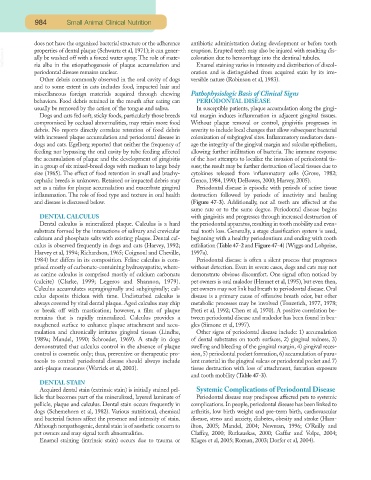Page 950 - Small Animal Clinical Nutrition 5th Edition
P. 950
984 Small Animal Clinical Nutrition
does not have the organized bacterial structure or the adherence antibiotic administration during development or before tooth
VetBooks.ir properties of dental plaque (Schwartz et al, 1971); it can gener- eruption. Erupted teeth may also be injured with resulting dis-
coloration due to hemorrhage into the dentinal tubules.
ally be washed off with a forced water spray. The role of mate-
Enamel staining varies in intensity and distribution of discol-
ria alba in the etiopathogenesis of plaque accumulation and
periodontal disease remains unclear. oration and is distinguished from acquired stain by its irre-
Other debris commonly observed in the oral cavity of dogs versible nature (Robinson et al, 1983).
and to some extent in cats includes food, impacted hair and
miscellaneous foreign materials acquired through chewing Pathophysiologic Basis of Clinical Signs
behaviors. Food debris retained in the mouth after eating can PERIODONTAL DISEASE
usually be removed by the action of the tongue and saliva. In susceptible patients, plaque accumulation along the gingi-
Dogs and cats fed soft, sticky foods, particularly those breeds val margin induces inflammation in adjacent gingival tissues.
compromised by occlusal abnormalities, may retain more food Without plaque removal or control, gingivitis progresses in
debris. No reports directly correlate retention of food debris severity to include local changes that allow subsequent bacterial
with increased plaque accumulation and periodontal disease in colonization of subgingival sites. Inflammatory mediators dam-
dogs and cats. Egelberg reported that neither the frequency of age the integrity of the gingival margin and sulcular epithelium,
feeding nor bypassing the oral cavity by tube feeding affected allowing further infiltration of bacteria. The immune response
the accumulation of plaque and the development of gingivitis of the host attempts to localize the invasion of periodontal tis-
in a group of six mixed-breed dogs with medium to large body sues; the result may be further destruction of local tissues due to
size (1965). The effect of food retention in small and brachy- cytokines released from inflammatory cells (Grove, 1982;
cephalic breeds is unknown. Retained or impacted debris may Genco, 1984, 1990; DeBowes, 2000; Harvey, 2005).
act as a nidus for plaque accumulation and exacerbate gingival Periodontal disease is episodic with periods of active tissue
inflammation. The role of food type and texture in oral health destruction followed by periods of inactivity and healing
and disease is discussed below. (Figure 47-3). Additionally, not all teeth are affected at the
same rate or to the same degree. Periodontal disease begins
DENTAL CALCULUS with gingivitis and progresses through increased destruction of
Dental calculus is mineralized plaque. Calculus is a hard the periodontal apparatus, resulting in tooth mobility and even-
substrate formed by the interactions of salivary and crevicular tual tooth loss. Generally, a stage classification system is used,
calcium and phosphate salts with existing plaque. Dental cal- beginning with a healthy periodontium and ending with tooth
culus is observed frequently in dogs and cats (Harvey, 1992; exfoliation (Table 47-2 and Figure 47-4) (Wiggs and Lobprise,
Harvey et al, 1994; Richardson, 1965; Coignoul and Cheville, 1997a).
1984) but differs in its composition. Feline calculus is com- Periodontal disease is often a silent process that progresses
prised mostly of carbonate-containing hydroxyapatite, where- without detection. Even in severe cases, dogs and cats may not
as canine calculus is comprised mostly of calcium carbonate demonstrate obvious discomfort. One signal often noticed by
(calcite) (Clarke, 1999; Legeros and Shannon, 1979). pet owners is oral malodor (Hennet et al, 1995), but even then,
Calculus accumulates supragingivally and subgingivally; cal- pet owners may not link bad breath to periodontal disease. Oral
culus deposits thicken with time. Undisturbed calculus is disease is a primary cause of offensive breath odor, but other
always covered by vital dental plaque. Aged calculus may chip metabolic processes may be involved (Tonzetich, 1977, 1978;
or break off with mastication; however, a film of plaque Preti et al, 1992; Chen et al, 1970). A positive correlation be-
remains that is rapidly mineralized. Calculus provides a tween periodontal disease and malodor has been found in bea-
roughened surface to enhance plaque attachment and accu- gles (Simone et al, 1997).
mulation and chronically irritates gingival tissues (Lindhe, Other signs of periodontal disease include: 1) accumulation
1989a; Mandel, 1990; Schroeder, 1969). A study in dogs of dental substrates on tooth surfaces, 2) gingival redness, 3)
demonstrated that calculus control in the absence of plaque swelling and bleeding of the gingival margin, 4) gingival reces-
control is cosmetic only; thus, preventive or therapeutic pro- sion, 5) periodontal pocket formation, 6) accumulation of puru-
tocols to control periodontal disease should always include lent material in the gingival sulcus or periodontal pocket and 7)
anti-plaque measures (Warrick et al, 2003). tissue destruction with loss of attachment, furcation exposure
and tooth mobility (Table 47-3).
DENTAL STAIN
Acquired dental stain (extrinsic stain) is initially stained pel- Systemic Complications of Periodontal Disease
licle that becomes part of the mineralized, layered laminate of Periodontal disease may predispose affected pets to systemic
pellicle, plaque and calculus. Dental stain occurs frequently in complications. In people, periodontal disease has been linked to
dogs (Schemehorn et al, 1982). Various nutritional, chemical arthritis, low birth weight and pre-term birth, cardiovascular
and bacterial factors affect the presence and intensity of stain. disease, stress and anxiety, diabetes, obesity and stroke (Ham-
Although nonpathogenic, dental stain is of aesthetic concern to ilton, 2005; Mandel, 2004; Newman, 1996; O’Reilly and
pet owners and may signal teeth abnormalities. Claffey, 2000; Rutkauskas, 2000; Gaffar and Volpe, 2004;
Enamel staining (intrinsic stain) occurs due to trauma or Klages et al, 2005; Roman, 2003; Dorfer et al, 2004).

